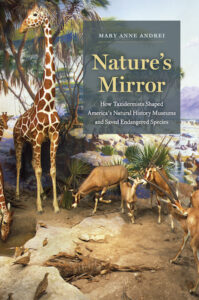 As anyone who – particularly as a child – has ever stood in rapt amazement before a well-crafted dioramic taxidermy display in a natural history museum can attest, their power to convey information as well as inspire interest is undeniable. However what is not as well known is the role museum taxidermists have played in the history of wildlife conservation in the nineteenth and twentieth centuries.
As anyone who – particularly as a child – has ever stood in rapt amazement before a well-crafted dioramic taxidermy display in a natural history museum can attest, their power to convey information as well as inspire interest is undeniable. However what is not as well known is the role museum taxidermists have played in the history of wildlife conservation in the nineteenth and twentieth centuries.
Uncovering and recounting the stories of such notable figures as William T. Hornaday, Carl E. Akeley, and others whose names have not necessarily become such familiar names today – but most certainly deserve to be – Mary Anne Andrei‘s new Nature’s Mirror: How Taxidermists Shaped America’s Natural History Museums and Saved Endangered Species is a most welcome and much needed book indeed.
Ms. Andrei’s book presents the complex and admittedly sometimes contradictory personalities of, and motivations behind, the people who brought to life some of the most well known natural history museum displays ever seen in the United States. In it she also examines how the creation of these displays brought to light the rapidly declining populations of some of the animals presented in them, as well as their visual power to influence public interest in their conservation.
If you enjoyed reading this, please consider signing up for The Well-read Naturalist's newsletter. You'll receive a helpful list of recently published reviews, short essays, and notes about books in your e-mail inbox once each fortnight.
